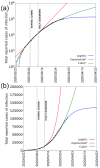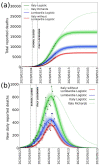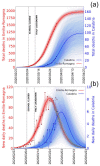The COVID-19 Infection in Italy: A Statistical Study of an Abnormally Severe Disease
- PMID: 32455807
- PMCID: PMC7291160
- DOI: 10.3390/jcm9051564
The COVID-19 Infection in Italy: A Statistical Study of an Abnormally Severe Disease
Abstract
We statistically investigate the Coronavirus Disease 19 (COVID-19) pandemic, which became particularly invasive in Italy in March 2020. We show that the high apparent lethality or case fatality ratio (CFR) observed in Italy, as compared with other countries, is likely biased by a strong underestimation of the number of infection cases. To give a more realistic estimate of the lethality of COVID-19, we use the actual (March 2020) estimates of the infection fatality ratio (IFR) of the pandemic based on the minimum observed CFR and analyze data obtained from the Diamond Princess cruise ship, a good representation of a "laboratory" case-study from an isolated system in which all the people have been tested. From such analyses, we derive more realistic estimates of the real extent of the infection as well as more accurate indicators of how fast the infection propagates. We then isolate the dominant factors causing the abnormal severity of the disease in Italy. Finally, we use the death count-the only data estimated to be reliable enough-to predict the total number of people infected and the interval of time when the infection in Italy could end.
Keywords: COVID-19; epidemic in Italy; statistical forecast.
Conflict of interest statement
The authors declare no conflict of interest.
Figures





References
-
- WHOa (World Health Organization) Rolling Updates on Coronavirus Disease (COVID-19) WHO; Geneve, Switzerland: 2020.
-
- Oke J., Heneghan C. Global COVID-19 Case Fatality Rates. Nuffield Department of Primary Care Health Sciences; Oxford, UK: 2020. [(accessed on 4 April 2020)]. Available online: https://www.cebm.net/global-COVID-19-case-fatality-rates/
-
- Van Rossum G., Drake F.L., Jr. Python Reference Manual. Centrum voor Wiskunde en Informatica; Amsterdam, The Netherlands: 1995.
-
- Akaike H. New look at Statistical-Model identification. IEE Trans. on Autom. Contr. 1974;19:716–723. doi: 10.1109/TAC.1974.1100705. - DOI
-
- Cereda D., Tirani M., Rovida F., Demicheli V., Ajelli M., Poletti P., Trentini F., Guzzetta G., Marziano V., Barone A., et al. The early phase of the COVID-19 outbreak in Lombardy, Italy. arXiv. 20202003.09320
LinkOut - more resources
Full Text Sources

